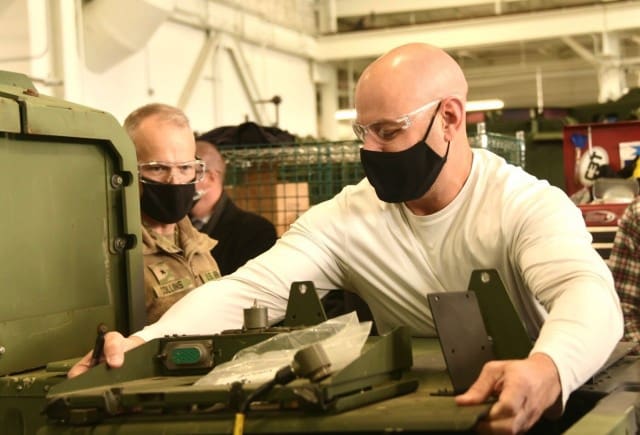ABERDEEN PROVING GROUND (APG), Md. (January 5, 2020) – Following the successful integration of its new more flexible and expeditionary network capability into dismounted units, the Army is now focused on delivering the same capabilities to Stryker brigade combat teams.

To produce uniform equipment packages for these Integrated Tactical Network (ITN) components across multiple Stryker variants, the Army has been conducting a Capability Set (CS) 21 ITN Stryker characterization effort with the 2nd Cavalry Regiment (2/CR), since April 2020. The effort will support the iterative modification of integrated ITN component designs into these vehicle platforms.
On the current timeline, the characterization will conclude in fiscal year (FY) 2022, making 2/CR the first Stryker unit equipped partially with CS21 ITN.
The Army first fielded CS21 ITN to the 1st Infantry Brigade Combat Team, 82nd Airborne Division in October 2020, with the next ITN fielding set for the 173rd Airborne Division this month.
“We are excited to move to this next phase of CS21, which will enhance mounted, on-the-move and at-the-quick-halt ITN capabilities,” said Lt. Col. Brandon Baer, product manager for Helicopter and Multi Mission Radios (HAMMR), assigned to the Program Executive Office for Command, Control, Communications-Tactical (PEO C3T).

The ITN approach injects new commercial components and network transport capabilities into the Army’s tactical network environment to provide maneuver brigades and below with smaller, lighter, faster and more flexible communications systems. Adding mounted ITN capabilities allows commanders to maintain battalion-wide terrestrial voice and data network and enables Soldiers to operate over the Secure But Unclassified (SBU) enclave while transitioning between dismounted and mounted operations.
“SBU continues to be the game-changing capability enabled by the ITN,” Baer said. “It allows data to be categorized according to its classification, which will be just as critical for our mounted units because data at battalion and below is often perishable and unclassified.”
To execute the CS21 ITN Stryker characterization, personnel from the HAMMR team are collaborating with engineers and technicians from the U.S. Army Combat Capabilities Development Command (DEVCOM) at the C5ISR Center Prototype Integration Facility (PIF), at APG. With Strykers at hand in the integration bay, the team will identify the most effective use of the limited space inside the vehicles, and then design and build the streamlined hardware required to integrate the ITN kits into the vehicles.
To ensure realistic operational requirements the PIF Team is directly collaborating with 2/CR, currently via video conferences due to COVID-19 travel restrictions.
“We have been conducting user juries remotely, which allowed the 2/CR Soldiers to show us their vehicle space restrictions, and in turn allows us to show them how much space our proposed designs will claim,” said Jim Leary, C5ISR PIF project engineer.
The 2/CR conducts missions using multiple commander and infantry carrier Stryker variants, with infantry carrier configurations most prevalent.
“Each vehicle within the 2/CR may require something unique to perform its mission, but our goal is to design a one-kit-fits-all variant approach,” Leary said.

The characterization led to the production of two unique ITN equipment kits. Kit one will be populated in almost every Stryker variant and features the mobile broadband kit for 4G LTE network capabilities, 2nd Generation Manpack radio, a mounted two-channel leader radio and a unique power distribution box, Leary said.
Kit two, slated for only the Command Vehicle Stryker variant, includes a Tactical Server Infrastructure computer, a Silvus radio, a Tactical Radio Integration Kit box, tactical cross domain solution and a power distribution unit, Leary said.
“Both kits will include various mounts, cabling, hardware and installation instructions, and will be adaptable to integrate into other 2CR tactical vehicles such as High Mobility Multipurpose Wheeled Vehicles, medium tactical vehicles (MTVs) and the MTV replacement, the Joint Light Tactical Vehicle, if available,” he said.
The most recent video conference user jury with the 2CR featured the team’s final proposed component designs and recommendations on where to place them in the vehicles’ available space, Leary said.
“Our last review was mostly favorable,” Leary said. “Next we will send PIF-produced 3D models of the kits to the 2/CR so that they can confirm the space we’re claiming is accurate or provide an alternate location for unique vehicle configurations.”
Following a verification and validation effort to systematically assess each component’s performance, and provided COVID travel restrictions are lifted, PM TR and PIF personnel will travel to the 2/CR in Germany to integrate CS21 ITN into Strykers from May through August. The entire characterization effort will culminate with a squadron-level exercise in September 2021, which will lead to the formal evaluation of the next capability set, CS23, in FY 2022.
“Our goal is always to build a design that repeats itself over and over again as opposed to making a unique design for every vehicle,” Leary said. “In doing so we save money, reduce the logistics footprint across multiple vehicle types, but most importantly, we make it as easy as possible for integration efforts across the entire force.”
By Kathryn Bailey, PEO C3T Public Affairs


I hope it’s better than the hot garbage land warrior system 2CR used in JMRC in ‘10.
173rd Airborne Division?
2CR? Did ACR go away?
Details aside, if successful, this would be the first time the dismounted and the mounted force were using an integrated battle command system.
The 173rd is still a Brigade. But the A is gone from 2 CR.